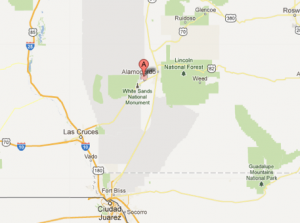 I hinted at this earlier, but it’s worth making explicit. In his reporting from Holloman Air Force Base, Mark Mazzetti revealed that the Air Force practices drone targeting on civilian traffic driving close to the base.
I hinted at this earlier, but it’s worth making explicit. In his reporting from Holloman Air Force Base, Mark Mazzetti revealed that the Air Force practices drone targeting on civilian traffic driving close to the base.
Holloman sits on almost 60,000 acres of desert badlands, near jagged hills that are frosted with snow for several months of the year — a perfect training ground for pilots who will fly Predators and Reapers over the similarly hostile terrain of Afghanistan. When I visited the base earlier this year with a small group of reporters, we were taken into a command post where a large flat-screen television was broadcasting a video feed from a drone flying overhead. It took a few seconds to figure out exactly what we were looking at. A white S.U.V. traveling along a highway adjacent to the base came into the cross hairs in the center of the screen and was tracked as it headed south along the desert road. When the S.U.V. drove out of the picture, the drone began following another car.
“Wait, you guys practice tracking enemies by using civilian cars?” a reporter asked. One Air Force officer responded that this was only a training mission, and then the group was quickly hustled out of the room.
What Mazzetti has described is a visual representation of the practice revealed in a new Air Force directive published by Secrecy News earlier this year–that the Air Force may collect imagery on US persons as part of training so long as it is “incidental.”
9.6.1. Air Force units with weapon system video and tactical ISR capabilities may collect imagery during formal and continuation training missions as long as the collected imagery is not for the purpose of obtaining information about specific US persons or private property. Collected imagery may incidentally include US persons or private property without consent. Imagery may not be collected for the purpose of gathering any specific information about a US person or private entity, without consent, nor may stored imagery be retrievable by reference to US person identifiers.
9.6.2. Air Force Unmanned Aircraft System (UAS) operations, exercise and training missions will not conduct nonconsensual surveillance on specifically identified US persons, unless expressly approved by the Secretary of Defense, consistent with US law and regulations. Civil law enforcement agencies, such as the US Customs and Border Patrol (CBP), Federal Bureau of Investigations (FBI), US Immigration and Customs Enforcement (ICE), and the US Coast Guard, will control any such data collected. [my emphasis]
The Air Force restricts the distribution of information collected “incidentally” (as much–other parts of the Directive makes clear–because it wants to hide its intelligence capabilities as because of any squeamishness about privacy).
Distribution of Domestic Imagery. Distribution of domestic imagery to parties other than those identified in the approved PUM, DIR or MFR is prohibited, unless the recipient is reasonably perceived to have a specific, lawful governmental function requiring it IAW paragraph 11.4. Unless otherwise approved, domestic imagery must be withheld from all general access database systems (e.g., Intelink).
But that doesn’t seem to rule out sharing with the National Counterterrorism Center (which after all, may now access any database it deems to have a counterterrorism interest), which can then cross reference that intelligence with any other government database.
And the Air Force directive specifically permits the sharing of information regarding violations of US or local laws.
11.12.2.1. Violations of US federal law. Incidentally acquired information reasonably believed to indicate a violation of federal law shall be provided to appropriate federal law enforcement officials through AFOSI channels.
Note where Holloman (and the likely highway in question) is located: right on a highway headed north from Ciudad Juarez, presumably a drug trafficking route.
Effectively, these “training” activities mean we’re using military drones inside the US to “incidentally” collect intelligence for the drug war, among other things. I’ve long suggested the first use of a lethal drone strike in the US will claim to have targeted cartel trafficking. I just didn’t yet have confirmation they’re effectively already doing anti-drug surveillance inside the US with drones.